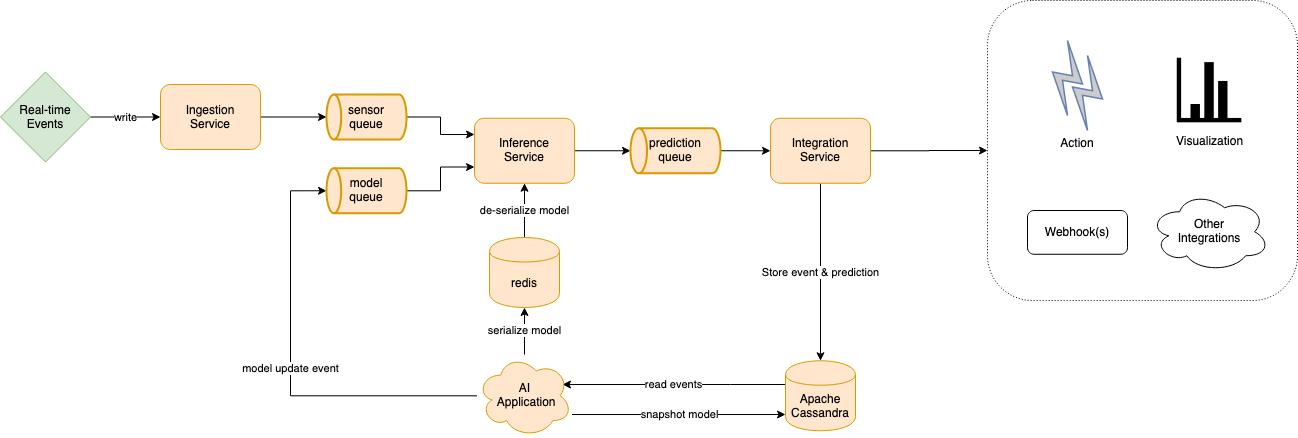ProjectsREFIT
Artificial Intelligence for the Internet of Things
From manufacturing and transportation to healthcare and urban planning, there have never been more applications for Internet of Things ecosystems. As the temporal value of streaming data grows - IDC predicts there will be 41.6 billion connected IoT devices, or "things," generating 79.4 zettabytes (ZB) by 20251 - speed and efficiency are becoming paramount not only in processing IoT data but in acting on IoT data as well. Traditionally, IoT-like systems leverage propositional logic from various components in order to take action on the data received. While this approach is effective, it can take a great deal of time and engineering effort to develop systems that can act on such data. Major cloud providers offer data streaming solutions (AWS Kinesis, Azure Stream Analytics, Google Cloud Platform Stream Analytics) that are based on proprietary components and lock in a user to the underlying infrastructure and tools of the cloud provider. REFIT is a system that is built to consume and capitalize on IoT infrastructure by ingesting device data and employing modern machine learning approaches to infer the status of various components of the IoT system. It is built on several open source components with state-of-the-art artificial intelligence and it is distinguished from other IoT systems:
- by not using any proprietary tools, and instead relying on recently released, powerful open-source components,
- by employing our machine learning research that enables features to be specified through a flexible logic which is propagated throughout the architectural components.
It decouples workload management and hardware from the software layer by using Kubernetes and docker containers. Open source REFIT handles many use cases with minimal customization and it also offers data source authentication to prevent spoofing and other possible attacks.
REFIT allows data injection through low latency streaming; the streamed data is stored in a high throughput persistent storage database which is augmented with other static data sources in order to train predictive AI models. The current trained model is pushed to the main processing unit that conducts predictions on real time data. The various data streams and predictions are stored in a persistent storage and can be visualized in real time in a dashboard.
Using REFIT’s predicted results, users can prioritize tasks and develop contingency plans so work may be done more efficiently while employing the same amount of resources. REFIT’s design also allows it to evolve and continuously improve its predictive abilities, while not disrupting the deployment of the current machine learning or deep learning approaches.

Select Use Cases for REFIT
REFIT’s data streaming architecture ensures the seamless deployment of new predictive models to the stream processing pipeline. The use cases span from agriculture and manufacturing to 5G and infrastructure monitoring.
Modern agricultural equipment is connected with various sensors connected wirelessly to the internet capturing for example the wind speed, temperature, and atmospheric pressure near each sensor, as well as a timestamp for when these measurements were taken and a unique sensor identification number. Another set of sensors can measure the mechanical state of the equipment. REFIT can be used to enable preventive maintenance or to control the deployment of pesticide, fertilizer, etc. In such a volatile industry having sophisticated automated solutions in place means survival during a downturn and prosperity in a positive economic environment.
Numerous use cases are already in existence in healthcare. Monitoring and predicting the malfunction of medical devices is of vital importance. On the other hand, patients are routinely monitored during their hospitalization or stay at home for signs of anomalies. REFIT has already been evaluated on predictions of development of certain medical conditions based on real-time monitoring of vital signs of patients.
Supply chains are increasing in complexity and customers are getting more demanding as competition is on the rise. On top of these the Covid-19 pandemic of 2020 called for further agility requiring the manufacturers and shippers to act and adjust in real time. Trucks, warehouses, and other relevant equipment are becoming robots in disguise with sensors monitoring the state. REFIT can be used to monitor the status of shipments, equipment and conditions and to produce preemptive actions based on predictive solutions.
Conclusion
Organizations and companies worried about vendor or cloud lockdown, or considering a transition to an end-to-end IoT software stack using state-of-the-art AI methodologies would benefit from REFIT. Its open source nature and flexibility mixed with ease of use are additional distinguishing factors. Any entity collecting data in real-time with a need for predictive modeling and/or visualization with low latency and high throughput should seriously consider REFIT.
